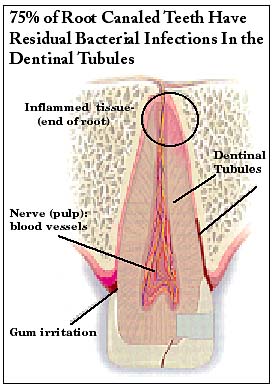Dr. Gerald H. Smith
A Biologic Approach to Root Canals
Conventional dental procedures offer a technique which does not take into account biocompatibility of the filling materials, potential injury to surrounding tissues due to the caustic nature of medicaments used and high percentage of residual bacterial contamination. According to research by Dr. Boyd Haley of the University of Kentucky, 75% of root canal teeth have residual bacterial infections remaining in the dentinal tubules. These lingering infections produce toxic wastes that enter the blood stream and can affect any part of the body. A dentist, Weston Price, brought this information to light in the 1940’s. Unfortunately for patients and the dental profession his scientific documentation and views were pushed aside. To date there is no acceptable conventional therapy to resolve this issue.
Conventional dental root canal therapy uses several materials that are not compatible:
- Gutta percha: used to seal the main canals after the nerves are removed. Gutta percha has cadmium, which is a toxic material.
- Eugenol based cements: this material is used to cement the gutta perch cones into the enlarged canals. Eugenol has an acid pH whereas the living tissues that surround the root have an alkaline pH.
- Clorox and hydrogen peroxide mixture: this combination is used to “sterilize” the inside of the main canals, which housed the nerve. Clorox and hydrogen peroxide both will injure tissue. A biologic approach to root canal therapy is less injurious and more biocompatible than standard procedures. Also a non-invasive test is now available to determine if any existing root canaled teeth are contaminated with bacteria and a potential source for medical problems. This test is now available at our office. The cost is $85 plus $35 for the office visit, postage and handling.
Biologic dental root canal therapy uses materials, which are biocompatible:
- Calcium hydroxide, calcium oxide and zinc oxide: these materials are availble from a compounding pharmacist. Each substance or combination of these substances MUST be tested for biocompatiblity with each patient!
- All three materials:calcium hydroxide, calcium oxide and zinc oxide are bactericidal and the materials have an alkaline pH that is similar to the surrounding tissues. Once tested these materials are mixed with those Sanum remedies that also tested compatible with the patient.
- Sanum remedies: these are homeopathic remedies from Germany that work like antibiotics but without any damaging effects. Colloidal silver: this solution is used instead of Clorox and hydrogen peroxide. Colloidal silver is capable of killing over 650 different forms of bacteria, viruses, Candida, and molds.
- Bio-frequencies: this technology was used in the early 1930’s and was extremely effective in destroying bacteria, viruses, molds, fungus, Candida and parasites.
Our preliminary research has shown that this approach is the only effective means that has a chance of resolving long standing residual bacterial infections in old root canaled teeth. There is no drug, homeopathic remedy, vitamin or mineral that can effectively kill these tiny bacteria that live in the small tubules that make up the root. Only the use of bio-frequencies has the capability of penetrating the surrounding bone and root without any damage to tissues. The number of treatments needed to treat this infection depends on the severity of the contamination level. A protocol of eight treatments is recommended. Each treatment takes approximately 90 minutes and costs $150 per session.
Garlic: contains germanium, a mineral that has both preventive and curative effect on cancer. It also has sulfhydral groups which bind to heavy metals like mercury, cadmium, aluminum. It works like a diruetic, antibiotic, antispasmodic, stimulant, expectorant, and digestant. Successfully used for high blood pressure, asthma, gas, colds, and intestinal parasites.
Dental Foci of Infection or Irritation

When teeth become inflamed because of trauma, fracture, decay or contaminated with bacteria, the tooth becomes a focus of infection or irritation. In the 1930’s, a dental researcher, Weston Price, implanted infected teeth into healthy rabbits. The rabbits came down with the same medical symptoms as those of its host. The rabbits exhibited heart, kidney, lung or other similar symptoms as manifested by the host. Dr. Price concluded that the toxins produced by the infected tooth found there way into the blood stream and was capable of causing disease within specific organs. In the 1940’s, the medical and dental professions both recognized such problems as valid and provided the basis for recommendations of tooth removal. In recent years a French medical/dental physician and researcher, Agnes Koubie, discovered that even a tooth whose pulp became inflamed from routine dental drilling could serve as the source for far removed arthritic type pains. If the distant pain resolved after injecting a local anesthetic around the offending tooth, Dr. Koubie concluded that the tooth was the underlying cause.
Cilantro: A Powerful herb That Works Like A Chelating Agent
Chelating agents are substances that bond to other substances. In nature sulfur has the ability to bond to toxins and heavy metals like mercury, cadmium, lead, aluminum and others. Animals instinctively seek out sulfur to heal themselves. When a dog gets sick it will eat grass. The young blades of grass possess high sulfur content and serves to neutralize toxins.
Cilantro is an herb that is commonly used in Thai, Vietnamese, and Mexican dishes. In addition to its culinary benefits, it has recently been discovered to be a powerful chelating agent. Yoshiaki Omura, MD, director of medical research at the heart Disease Foundation and president of the International College of Acupuncture in New York, reported that after finding he had been heavily exposed to mercury, he accidently discovered that when cilantro is taken in a slightly cooked form it causes a massive secretion of mercury in the urine.
Dietrick Klinghardt, MD, Ph.D also recommends cilantro as the best means to remove mercury from the brain. His clinical research has found that 5 grams (teaspoonful) a day is the minimum dose.
Cilantro can easily be prepared by finely chopping one heaping teaspoonful of fresh cilantro and placing it in either chicken soup or boiled water and allowed to steep for twenty minutes. One can sip the tea through out the day.

